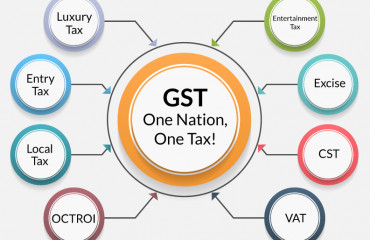
Under India’s Goods and Services Tax (GST) law, states were guaranteed bi-monthly compensation for any loss of revenue in the first 5 years of GST implementation from 1 July 2017. The shortfall is calculated assuming a 14% annual growth in GST collections by states over the base year of 2015-16. The 5-year period will end on 30 June and there is a growing demand from many states to extend the GST compensation mechanism beyond that. The amount to be paid from the compensation fund is obtained by levying a cess on top of the highest tax slab on luxury, demerit and sin goods.
Under India's Goods and Services Tax (GST) law, states were guaranteed bi-monthly compensation for any loss of revenue in the first 5 years of GST implementation from 1 July 2017. The shortfall is calculated assuming a 14% annual growth in GST collections by states over the base year of 2015-16. The 5-year period will end on 30 June and there is a growing demand from many states to extend the GST compensation mechanism beyond that. The amount to be paid from the compensation fund is obtained by levying a cess on top of the highest tax slab on luxury, demerit and sin goods. Though state governments want GST compensation extended, they are aware that the proceeds of GST cess collection will have to be used to service the debt raised in the last two financial years to meet the compensation shortfall.
Given this uncertainty over the extension of GST compensation and the possibility of it tapering off at least in the medium term, it is imperative for states to devise strategies towards prudent public expenditure management. As the share of committed expenses in the total expenditure of many bigger states is high, additional fiscal space can only be created through two routes: either by exploring avenues for enhancing both tax and non-tax revenues or by careful expenditure management. As possibilities for the first route are constrained within the federal system, the second route could be a pragmatic approach. In this context, getting expenditure priorities right and efficiently utilizing funds is of paramount importance.
The 13th Finance Commission had suggested that due weightage be given to "the need to improve the quality of public expenditure to obtain better outputs and outcomes" from fiscal transfers. An important constituent of the quality of public expenditure is reducing committed expenditures in budgets and focusing on outlays that are "future-" and "growth-oriented". This entails an assessment of the institutional arrangements relevant to the fiscal rules and budgetary procedures in states. As a first step, a system of performance budgeting was introduced to assess performance against set goals/objectives. However, this was not able to establish a clear one-to-one relationship between financial budgets and performance. Moving further in this direction, outcome budgeting was introduced in 2006-07, which also recognized that outlays do not necessarily mean outcomes. It is in this context that a framework suggested by a Reserve Bank of India (RBI) study in 2009 becomes relevant. This study proposes a "triple E framework" to assess expenditure quality, which has constituents of expenditure adequacy, effectiveness and efficiency. Expenditure adequacy is in terms of focusing on the government's primary role, effectiveness is about assessing performance, and efficiency involves an assessment of the output-input ratio.
Present patterns of public expenditure in many states are unlikely to pass the test set out by the RBI study's 'triple E' framework. As new models of welfarism have emerged, the adequacy of spends on provisioning for public goods itself is under strain. Newer and narrower lists of public goods have been the outcome of expenditure provisioning, and these are not necessarily future-oriented. The classic case of new welfarism has been the proliferation of subsidies and freebies. Increased allocations for these have often resulted in inadequate allocations for public goods, and hence, low provisioning levels. Once expenditure adequacy is undermined with expanded subsidies and freebies, the scope for assessing effectiveness and efficiency gets narrower and is limited to expanding the coverage of such schemes. States would ultimately indulge in a distorted version of fiscal competition to expand their scope and penetration, resulting in a race to the bottom in terms of provisioning for future growth.
Even though freebies and subsidies increase private consumption and could generate growth in the short term, these reduce fiscal space in the long term. That is, the availability of budgetary room that allows state governments to provide resources for a higher growth trajectory without any threat to the sustainability of their financial position gets curtailed. This calls for a rationalization of expenditure, which includes reassessing the continued desirability of specific expenditure programmes, such as unbridled subsidy expansion. Such an approach would also help in realizing possible efficiency gains in the provision of public goods and services, and thus create fiscal space which could then aim for an expenditure mix that is more effective in promoting growth.
At this juncture, there exists a need for states to look beyond GST compensation and adopt a long-term view to manage finances. Armed with enhanced collective bargaining power, even if GST compensation gets extended beyond June, states shall only gain a short-term source of revenue. The long-term solution rests on state efforts at revenue raising, expenditure re-prioritization or rationalization and judicious borrowings. These would raise their potential growth trajectory and open up alternate channels for the creation of fiscal space.
State finance commissions (SFCs) should play a key role in this agenda. Unfortunately, in most states, state governments are either apathetic towards the institution of SFCs, or, in certain cases, poor implementers of the recommendations made. For the sake of their own finances, states must change this.
M. Suresh Babu & Aditya Sinha are, respectively, adviser and additional private secretary, research, Economic Advisory Council to the Prime Minister
